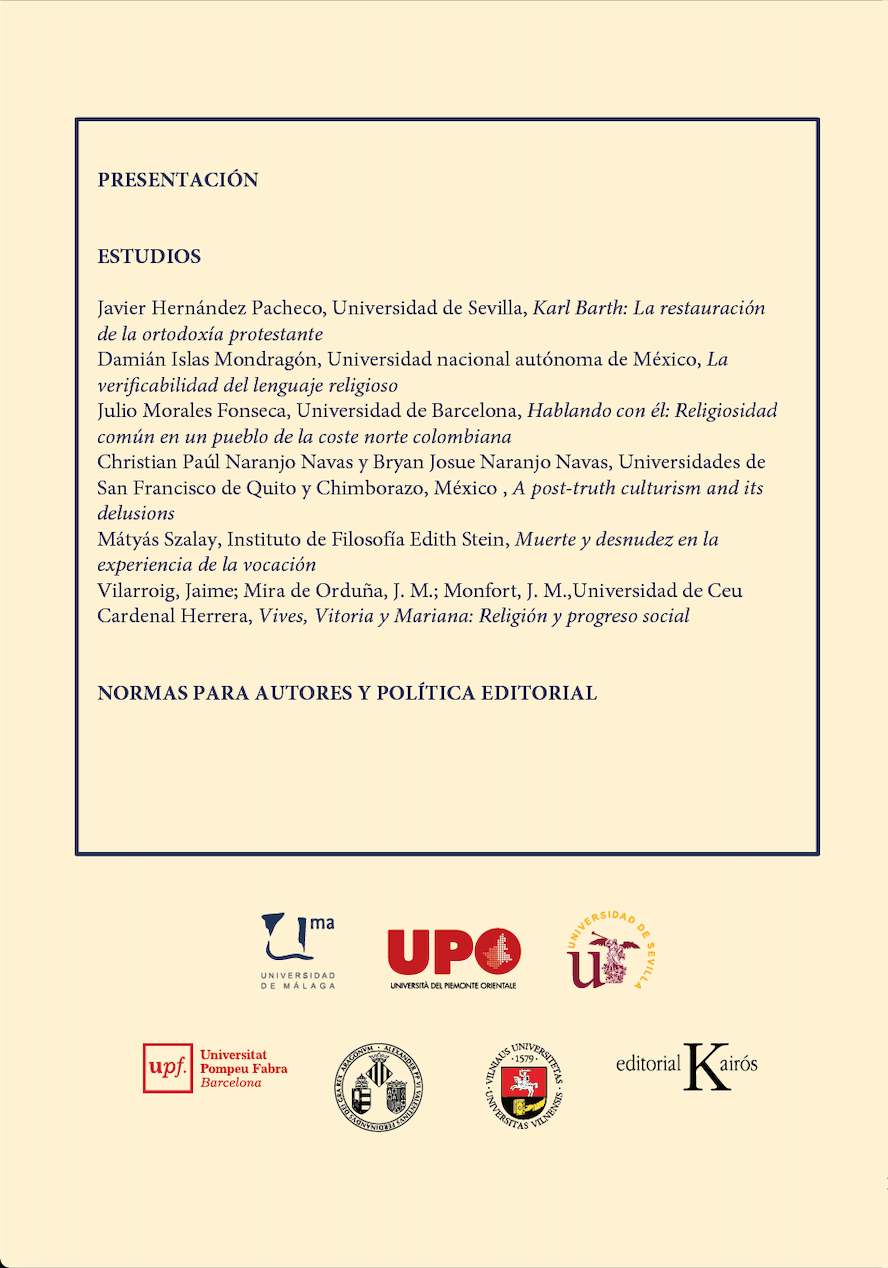DEATH AND NAKEDNESS IN THE EXPERIENCE OF VOCATION
DOI:
https://doi.org/10.24310/Raphisa.2019.v0i5.5430Keywords:
VOCATION, PHILOSOPHY, AESTHETICS, DEATH, NAKEDNESS, CASORATIAbstract
This short essay is supposed to complement the argumentation of my book, Bevezetés a hivatásfilozófiájába [Introduction to the philosophy of vocation], concerning an essential aspect for it analyses the experience of the vocation from the point of view of its peculiar aesthetics. By interpreting Felice Casorati’s painting entitled Vocation I focus on five aspects. First, concerning the nakedness, I illuminate the relation between saint and profane. In the second part, I try to grasp the subject of the recipient of vocation, i.e. one of the protagonists of this dramatic encounter. The third point is dedicated to the question of the meaning-context of vocation. I argue that it is essentially characterized by hope. The fourth chapter describes the specific time-experience of vocation. As a fifth step once again I ask the main question here: who calls in the vocation? The last point summarizes those five essential aspects that could help us to live and to manifest the vocation as the fullest meaning of our existence.
Downloads
Metrics
References
? G. BERTOLINO, F. POLI, V. CARIOGGIA, “Memorie su Felice Casortai” (Canale Arte, 2013) en: https://www.youtube.com/watch?v=RTjy6yCRMNQ (2016.08.08.)
? P. D. AREOPAGITA, “De divinis nominibus”, en B. R. SUCHLA (dir.), De divinis nominibus (Walter de Gruyter, 1990), IV, 7, 135.
? U. ECO Arte y belleza en la estética medieval (Editorial Lumen, Barcelona, 1997
? J. L. CHRÉTIEN, The call and the response. No. 33. (Fordham Univ. Press., 2004)
? H. BALTHASAR, Herrlichkeit: Schau der Gestalt. I. (Johannes Verlag, 1961).
? H. BYUNG-CHUL,Transparenzgesellschaft (Matthes&Seitz, Berlin, 2012)
? H. BYUNG-CHUL, Die Errettung des Schönen(Fischer Verlag, Frankfurt am Main, 2015).
? F. MERINO ESCALERA, “La vocación de la mujer y el feminismo de Edith Stein”, en Cuadernos de Pensamiento: Vol. 13. (1999)93-109.
? R. M. RILKE, “Archaischer Torso Apollos” , en R. M.RILKE, Werke in drei Bänden , Vol. 3. (Insel, 1966)
? H. L. KESSLER, “Turning a Blind Eye: Medieval Art and the Dynamics of Contemplation”, en The Mind’s Eye: Art and Theological Argument in the Middle Ages (Department of Art and Archaeology, Princeton University, 2006) 413-439.
? R. G. COLLINGWOOD, The principles of art. Vol. 11. (Oxford University Press, USA, 1958).
? H. BALTHASAR, “Theology and Sanctity”, en The Word Made Flesh (San Francisco, 1989) 181-209
? P. HENRICI, “Hans Urs von Balthasar: A Sketch of his life”, en D. L. SCHINDLER (dir.), Hans Urs von Balthasar: His Life and Work (Ignatius Press, 1989) 7-44.
? H. BALTHASAR, “Adrienne von Speyr: Über das Geheimnis des Karsamstags”, en: Internationale Katholische Zeitschrift Frankfurt (1981), 10/1, 32-39.
? H. BALTHASAR, Theologie der drei Tage (Johannes-Verlag, 1990).
? G. BERTOLINO, F. POLI, V.CARIOGGIA, “Memorie su Felice Casortai” (Canale Arte, 2013) en: https://www.youtube.com/watch?v=RTjy6yCRMNQ (2016.08.08.)
? J. CHÁNTILLON, “NudumChristusnudussequere. A Note on the Origins and Meaning of the Theme of Spiritual Nakedness in the Writings of S. Bonaventure”, en S. BONAVENTURA 1274-1974 4. vols. (Grottaferrata Collegio S. Bonaventura, 1974) 719-772.
? R. GRÉGOIRE, “L’adage ascétique ’Nudus nudum Christum sequi”, en Studi storici in onore di Ottorino Bertolini, 1. vol. (Pisa, Pacini, 1972) 395-409.
? F. MORANDO, “Nudusnudum Christum Sequi. The Franciscans and Differing Interpretations of Male Nakedness in Fiftheen Century Italy”, en E. E.DUBRUCK, B. I. GUISICK, Fiftheen Century Studies. Vol. 33. (CadmenHouse, Suffolk, 2008), 171-198.
? K. CLARK, The Nude. A Study in Ideal Form (John Murray, London, 1956)
? M. PROUST, Sodome et Gomorrhe (le livre de poche, 2012).
? H. DE LUBAC, Le mystère du surnatural (Editions Aubier Montaigne, Paris, 1965).
? B. BLESAN, “Devenir cuerpo en la sociedad de consumo”, en Revista Internacional de Filosofia, No 66 (2015) 121-133.;
? F. HADJADJ, La profondeur des sexes: pour une mystique de la chair (du Seuil, 2008)
? J. M. FIDALGO, “Fabrice HADJADJ, La profundidad de los sexos. Por una mística de la carne, Granada: Nuevo Inicio, 2010, 302 pp.” en ScriptaTheologica 44/1(2015) 259.
? M. CHRISTENSEN, J. WITTUNG (dir.), Partakers of the Divine Nature. The History and Development of Deification in the Christian Tradition (Farleigh Dickinson University Press., 2006), en: http://www.sgtt.org/Writings/Patristics/Deification.html (07.10.2016).
? ATHANASIUS, De Incarnatione. 54 en: E. P. MEIJERING, Saint ATHANASIUS, J. C. M. VAN WINDEN. Athanasius, De incarnatione verbi: Einleitung, Übersetzung, Kommentar. (JC Gieben, 1989)
? GREGORIO DE NISA, Orationes
? B. MEZEI, Vallásbölcselet. A vallásvalósága (I-II), (Attraktor, Máriabeseny?-Gödöll?, 2004).
? J.A. MCGUICK, “Deification in Greek Thought: The Cappadocian Fathers’ Strategic Adaptation of a Tradition”, en M. J. CHRISTENSEN, A. W. JEFFERY, Partakers of the Divine Nature: The History and Development of Deification in the Christian Traditions, (Baker Academic, 2008)
? F. NIETZSCHE, Über Wahrheit und Lüge im außermoralischen Sinn:[Was bedeutet das alles?], (Reclam Verlag, 2015).
? J. RATZINGER, Jesus of Nazareth: Holy Week: From the Entrance into Jerusalem to the Resurrection. Trans. Vatican Secretariat of State (Ignatius, San Francisco, 2011).
? San. AGUSTÍN, Las confesiones (Ediciones AKAL, 1986)
? M. HEIDEGGER, Phänomenologie des religiösen Lebens. Gesamtausgabe, Vol. 60. en M. JUNG, Th. REGEHLY, C. STRUBE (dir.), (Vittorio Klostermann, Frankfurt am Main, 2011). II. Parte
? D. HILDEBRAND, Die Umgestaltung in Christus. Gesammelte Werke, Vol . 10. (von Hildebrand-Gesellschaft, 1971) 70.
? H. DE LUBAC, Le mystère du surnatural (Editions Aubier Montaigne, Paris, 1965).
? J. H. MCKENNA, “Theology of Adoration”, en: Vincentiana, 49/1, (2005), Article 16.
? San AGUSTIN, Sermo. 88.6 PL 38542. in: D. L. Schindler, Hans Urs von Balthasar: his life and work, (Ignatius Press, 1991) 43.
Downloads
Published
How to Cite
Issue
Section
License
License permitted by the journal: Public Domain. Authors retain the copyright and full publishing rights without restrictions.






